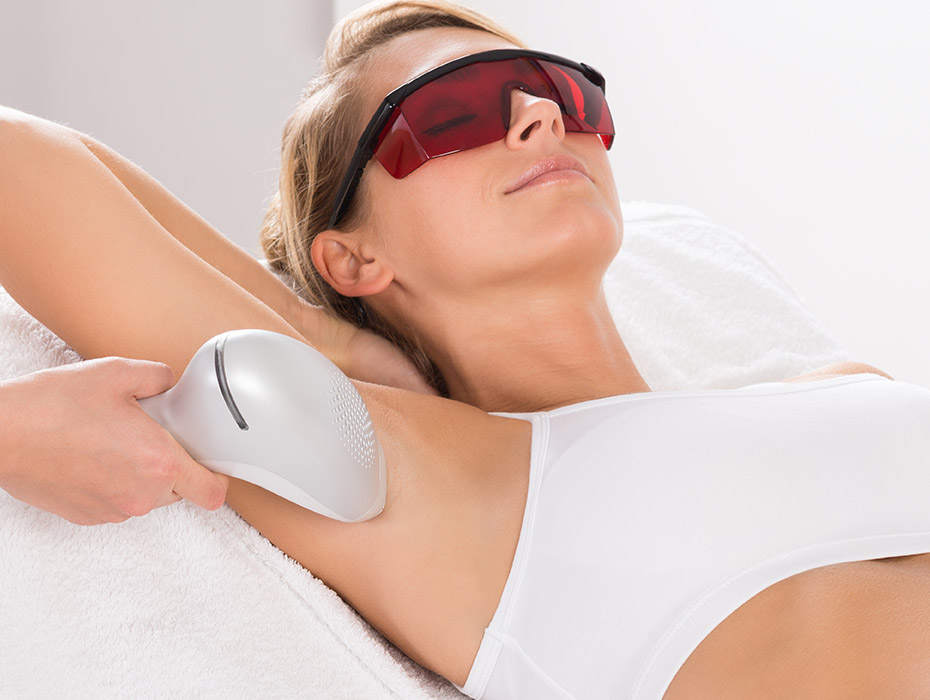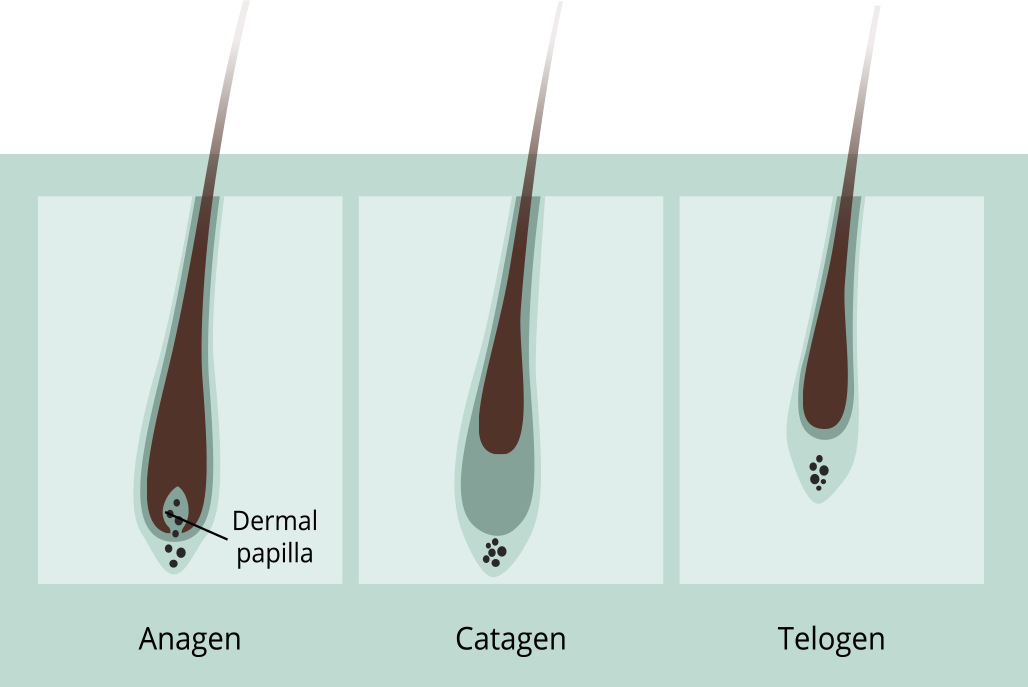Unwanted hair is an embarrassing problem for both men and women. Noninvasive laser hair removal has become the gold standard for permanent hair removal with no down time and little maintenance needed. Shaving, waxing, and electrolysis are not only painful, but must be repeated indefinitely. At our medical spa, Dermlounge, Dr. Neil J. Zemmel has the expertise and knowledge to safely help reduce and possibly eliminate unwanted hair from any part of the body or face.
How Laser Hair Removal Works

At Richmond Aesthetic Surgery we use an Apogee Elite-Alexandrite (755nm) & ND YAG (1064nm) laser that is shown to provide excellent results for all skin types. It is proven effective on all parts of the body including bikini, armpits, legs, arms, face, abdomen, chest, and back. The laser targets the pigment called melanin of the hair follicle and sends a heated beam of light to permanently alter the hair follicle and eliminate growth. Patients with darker hair and fair skin are the best candidates, but it is safe and effective in darker skin tones at lower settings. Unfortunately, the laser is not effective for blonde, grey, or white hair because the laser cannot differentiate between the skin and the hair, due to the lack of pigment. Patients should expect to have approximately 6 treatments, each one 4-8 weeks apart, depending on the body area treated, for optimal results. Hair grows in several different cycles, and in order to have permanent hair removal, you must treat the areas when the hair is in the active growth phase. In any one area, you will have hair in all stages. Therefore multiple treatments are required for the best results. Most patients can expect up to a 30% reduction of hair after the first treatment.
Stages of Hair Growth
Hair is present on almost all the surfaces of the body in both men and women. There are many factors that contribute to the growth of hair, including exercise, diet, genetics, hormones and hair type. It is also known that hair grows the quickest during the winter making it the best time to begin permanent laser hair removal treatments. Hair growth occurs in three cycles: anagen phase, catagen phase, and the telogen phase. Once a hair goes through all of the phases it then starts all over again.

The Anagen Phase
This phase is the active growth phase of hair and is the longest of all three. Genetics is the main factor that influences this stage of hair growth. The hair continues to lengthen as dead cells of keratin are continually pushed to the surface of the skin. As a long as a hair stays in this phase, it will continue to grow for up to eight years. The average rate of hair growth is 1.25 centimeters per month and 85% of hair on the head is in the antagen phase at one time. It is during this stage only that permanent laser hair removal is effective.
The Catagen Phase
After the anagen phase is complete, hair then enters the catagen phase, also known as the transitional phase. During these two weeks, the papilla detaches from the hair follicle and does not allow any more nutrients to reach the hair. The sebaceous glands, which provide oil to the skin, also secrete less sebum, and in return hair growth ceases and the hair follicle shrinks in size. The hair is dormant during this phase but is not shed.
Telogen Phase
The telogen phase is the final stage of hair growth and lasts approximately three months. During this time the hair is still attached to the follicle but does not grow. A new hair begins to grow in the anagen phase and the existing hair strand is pushed out by the new growth. We lose almost 100 hairs in a given area when the telogen phase is complete. Fortunately for humans, only 15% of our hair is in the telogen phase at a given time so the shedding goes unnoticed.
Laser Hair Removal Procedure
Laser hair removallaser hair removal
Patients should arrive to their appointment with a clean, close shave. The laser will target the hair shaft below the skin surface where it will disable further growth. Long hair present on the skin surface will waste the laser energy, “singe” it, thus never targeting the intended structure which is the hair root sheath that lies below the skin surface. The hair root below the skin surface needs to be present in order to be targeted by the laser; therefore, it is best not to wax, pluck, or use depilatory creams for at least 4 weeks prior to the treatment. Dr. Zemmel also recommends that patients not arrive at their appointments with any self-tanners, tanning bed, sunburn, or new tan within 2 weeks leading up to your appointment. Any darkening or pigment changes of the skin, even if not visible to the human eye, will be detected by the laser and therefore reduce the amount of hair eliminated per session.
Every patient responds differently to laser hair removal. There is always a small chance that the hair will not be completely eliminated within the six treatments. In most cases, hair production is eliminated by approximately 90%, and any remaining hair is much softer and finer to start with.
Aftercare for Laser Hair Removal
There are very few complications related to laser hair removal. The most common side effects include redness and mild swelling of the treated areas that resolve within 24 to 48 hours. Aloe Vera gel and cold compresses will be provided immediately following the procedure. There is no downtime for activities with laser hair removal; however, we recommend not overheating the body by avoiding the sun or very hot showers for the first 48 hours to avoid prolonged redness, swelling, or blistering of the skin. A small percentage of our patients will have mild oozing and crusting of the skin within the first 24 to 48 hours after treatment. If any small blisters arise, do not “pop” them; simply allow the body to reabsorb the fluid. If the blister opens, then apply an antibiotic ointment such as over the counter bacitracin. Our team will also provide you with detailed written instructions after the procedure.
Laser Hair Removal Areas
- Abdomen (Male): just below the pec muscles, extending down to 3 finger widths below umbilicus
- Abdomen Lower (Female): starting at bottom of umbilicus, down to start of pubic hair
- Abdomen Upper (Female): starting at fold beneath breasts down to top of umbilicus
- Areola: area around the nipples
- Arms: from the edge of underarms, down to the fingers
- Arms Lower: all hair starting just above the elbow bone down to the wrist fold
- Arms Upper: top of deltoid down to top edge of elbow bone
- Back: starting at the edge of the collarbone, blending into the deltoids of the upper arms, down to the waistline or top of buttocks crease, to lateral edges of back where underarms start; no neck region included
- Back Lower: bottom edge of shoulder blades down to waist line or top of buttocks seam and along sides
- Back Upper: starting at top of collarbone, blending into deltoids, extending down to bottom edges of shoulder blades, does not include back side of neck
- Bikini – Traditional (Female): happy trail ½ inch wide if present, 1 finger width across the top of pubic hair line, and any hair falling outside the underwear line up to 3 finger widths wide
- Bikini – Full (Female): traditional bikini areas plus as much pubic hair removed as you desire, including 2 finger widths wide on either side of anus region to top of buttocks seam
- Bikini (Male): 3 finger widths outside of groin, full pubic area, and 2 finger widths on either side of anus region extending to top of buttocks seam
- Breasts: entire breasts including around the nipples
- Buttocks: starting at the top of buttocks seam and across to lateral edges of buttocks, into middle fold including anal area, down to where the buttocks fold meets top of legs
- Cheeks: full middle of face on either sides of nose, not including 2 finger widths wide of sideburns starting edge of ear, below bony ridge of lower eyes, along nose, to edges of mouth
- Chest (Male): from top of collarbone down to fold where pecs end, extending to edge of underarms
- Chin: area extending straight below the lower lip, down to 3 finger widths below jawline
- Ears: the full of ear, front and back, and just outside of ear canal
- Eyebrow: area between eyebrows and any sculpting in the temple region
- Face: cheeks, chin, upper lip, and sideburns
- Feet: starting below ankle bones to across the toes
- Hands: starting at the wrist bone and across to full fingers
- Head Scalp: full head extending to top of forehead, includes sideburns, stops at posterior neck
- Legs: starting 3 finger widths away from groin or bikini line, extending down legs, all the way to toes
- Legs Lower: top edge of knee, down to bottom of ankle bone
- Legs Upper: starting 3 finger widths outside groin or bikini line and start of buttocks seam, extending down to just above the kneecap bone
- Lip Upper: full area above the mouth, up to edge of nostrils, out to both corners of where lips touch
- Neck (Back Side): starting at edge of hairline down to line of collarbone
- Neck (Front): from jaw line down to the collar bone
- Nose: any hair covering the top surface of nose, stops at start of hair between eye brows
- Shoulders: the tops of the shoulders to the collarbone, to the lower edge of neckline, blending into deltoid; does not include back side of neck leading up to scalp hair
- Sideburns: 3 finger widths wide next to ear, straight down to edge of jawline and to the corner of the mouth
- Underarms: the full arm pits, both sides






































